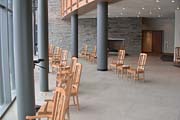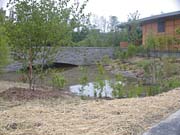
About three miles outside of Cornell University's main campus in Ithaca, NY, a two-story observation laboratory has been built to fit its new surroundings. Officially opened to the public on June 21 of this year, Cornell's lab of ornithology has established its new home on the eastern shore of the Sapsucker Woods Pond in Ithaca, NY. Formally named the Imogene Powers Johnson Center for Birds and Biodiversity, the building's architecture has been strategically designed to fit its new environmental habitat. Although the building is five times the size of the original lab, the mix of cedar wood and locally quarried Llenroc stone allows the building to fit in as a subtle addition to the wetland woods.
The building site was surrounded by fragile ecological conditions, causing developers to pay close attention to natural boundaries. The goal of this project was to create a building that was larger than the previous one, but manipulate the structure to appear smaller. “By creating a larger ground level and geometrically varying
roof slopes and curving walls simultaneously, the overall mass of the building was reduced,†said Technical Specialist Charles Maira of Hillier. “Making it a welcoming addition to its new habitat was important. Studies were done to find ways that the building would be least invasive. For example, zinc was selected for the primary roof material as the visible, sloping structure. The zinc was specifically chosen because it had no lead content and no traces of copper, making it environmentally friendly,†explained Maira. Caution was used in other elements of the environment in order to limit the intrusion of the new building on its new surroundings. “The environmental engineer supervised site construction during the project. Not only that, the amount of the land that was touched had to be replaced 200%,†said Maira.
The Llenroc stone was used to create the interior and exterior architecture and was quarried locally through Finger Lakes Stone Co. Inc. in Ithaca, NY. Known as a form of New York State Bluestone, Llenroc is a native stone to the Cornell University campus and had been used for two previous projects. For the Imogene Powers Johnson Center, 20,000 square feet of the Llenroc limestone was used to complete the interior and exterior walls, including the two large walls that house the main lobby space, the observatory and the entrance bridge. The stone varied in size and either had a seamed face, a natural cleft finish or a combination of the two finishes. It was also diamond rubbed for copings and trim stone, according to Maira.
“In the observatory, French limestone was the predominant floor material with carpet inlay,†explained Maira. “The French limestone - with a flamed finish - is a natural limestone and varies in color from warm gray to beige. The French limestone was chosen because it offers a color that is complimentary to the Llenroc stone.â€
During the two years of construction one challenge did occur but did not prevent continuation of the building. The weather conditions during the installation of the zinc were a hindrance on the project. “The weather was too cold,†said Maira. “The zinc was not friendly to the cold weather. This caused a bit of delay in the schedule because working with it was difficult.â€
Completed in the beginning of the summer of 2003, the feedback from people has been excellent. “The biologists, scientists and clients involvement was very intense and they seemed to be happy,†said Maira.

End box:
Imogene Powers Johnson Center for Birds and Biodiversity, Cornell University, Ithaca, NY
Architect: Hillier, Princeton, NJStone Supplier: Finger Lakes Stone Co. Inc., Ithaca, NY
Stone Installer: Christa Construction, Victor, NY